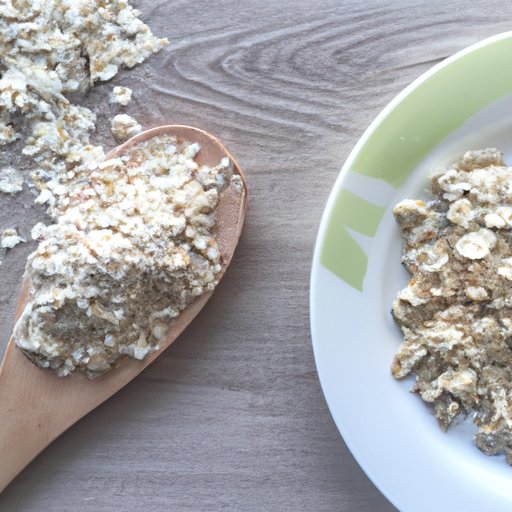
I. Introduction
Many people struggle with losing weight, and often turn to fad diets or expensive weight loss products for a quick fix. However, the key to sustainable weight loss is making healthy dietary choices that can be maintained long-term. One such choice is incorporating oatmeal into your diet. In this article, we will explore the science behind oatmeal and weight loss, share five delicious oatmeal recipes perfect for weight loss, offer tips for incorporating oatmeal into your daily diet, compare oatmeal to other breakfast foods for weight loss, and provide a balanced overview of oatmeal’s potential pros and cons for weight loss success.
II. The Science Behind Oatmeal as a Weight Loss Tool
Researchers have found that consuming oatmeal can aid in weight loss by boosting metabolism and decreasing hunger levels. The high fiber content of oatmeal helps keep you feeling full for longer periods of time, reducing overall calorie intake. In addition, the beta-glucan in oatmeal can improve insulin sensitivity and reduce inflammation in the body. Studies have shown that consuming oatmeal regularly can lead to moderate weight loss and improved body composition. While the research on oatmeal and weight loss is promising, it is important to note that oatmeal should be consumed as part of a healthy, balanced diet and not relied on as a sole weight loss solution.
III. 5 Delicious Oatmeal Recipes Perfect for Weight Loss
1. Blueberry Banana Baked Oatmeal: In a mixing bowl, mash one banana and mix with 1 cup of old-fashioned oats, ½ cup blueberries, 1 tsp baking powder, 2 tbsp almond milk, and 1 tbsp maple syrup. Pour mixture into a baking dish and bake at 375°F for 25 minutes. Serve warm.
2. Peanut Butter and Jelly Overnight Oats: In a jar, layer ½ cup of old-fashioned oats, 1 tbsp chia seeds, 1 tbsp natural peanut butter, ¼ cup sliced strawberries, and ¼ cup almond milk. Leave in the fridge overnight. In the morning, stir and enjoy.
3. Cinnamon Apple Oatmeal: Cook ½ cup of old-fashioned oats in 1 cup of water. Add 1 diced apple, 1 tsp cinnamon, and 1 tbsp honey. Simmer for 5 minutes and serve.
4. Sweet Potato Pie Oatmeal: In a pot, bring 1 cup of almond milk to a boil. Add ½ cup of old-fashioned oats, 1 tsp cinnamon, and 1 tbsp maple syrup. Once oats are cooked, add ½ cup mashed sweet potato and stir. Serve hot.
5. Chocolate Cherry Oatmeal: Cook ½ cup of old-fashioned oats in 1 cup of almond milk. Add ½ cup cherries, 1 tbsp cocoa powder, and 1 tbsp honey. Simmer for 5-10 minutes and serve.
These oatmeal recipes are full of whole foods, fiber, and protein to keep you feeling satisfied and energized throughout the day.
IV. How to Incorporate Oatmeal Into Your Daily Diet for Weight Loss Success
To incorporate oatmeal into your daily diet, start by choosing the right type of oats. Steel-cut and rolled oats are the most nutritious, as they are less processed than instant oats. Next, try experimenting with different toppings and additions to keep your oatmeal interesting. Some healthy toppings include fresh fruit, nuts, seeds, or a drizzle of honey. You can also try different cooking methods, such as overnight oats or baked oatmeal, to switch things up. Pairing your oatmeal with other healthy foods, such as eggs or avocado toast, can also provide a balanced, satisfying meal. When faced with time constraints or limited cooking ability, pre-packaged oatmeal cups can provide a quick and easy breakfast option.
V. Oatmeal vs. Other Breakfast Foods: Which is Best for Weight Loss?
Compared to other popular breakfast foods such as cereal, bagels, or muffins, oatmeal is a better choice for weight loss. While all of these foods can provide carbohydrates for energy, oatmeal has a lower calorie count and higher fiber content than many other breakfast options. In addition, the complex carbohydrates in oatmeal provide sustained energy throughout the morning, reducing the likelihood of snacking on unhealthy foods before lunchtime. That being said, it is important to choose your oatmeal toppings wisely and avoid adding excess sugar or refined carbs to your meal.
VI. The Pros and Cons of Eating Oatmeal for Weight Loss
Oatmeal can certainly be a helpful tool for weight loss, thanks to its high fiber content and ability to keep you feeling full for longer periods of time. Additionally, oatmeal is a versatile food that can be used in a variety of recipes and meal plans. However, it is important to remember that oatmeal alone is not a magic weight loss solution. Depending on the type of oatmeal and toppings used, it can be high in calories and sugar. Additionally, not everyone loves the taste or texture of oatmeal, which can make it difficult to incorporate into a daily diet.
VII. How Oatmeal Helps You Lose Weight, Backed by Real-World Success Stories
Many people have successfully used oatmeal as a weight loss tool, with some even attributing significant weight loss to incorporating oatmeal into their diets. One person reported losing 100 pounds by incorporating oatmeal into their daily routine and making other dietary changes. Another individual reported losing 50 pounds by consuming oatmeal with fresh fruit and nuts every morning, which helped keep them full throughout the day and prevented snacking on unhealthy foods. While anecdotal evidence cannot be used to make sweeping claims about the effectiveness of oatmeal for weight loss, these stories do provide real-world examples of how oatmeal can be a helpful tool when used in conjunction with a healthy, balanced diet.
VIII. Conclusion
In conclusion, oatmeal can be a helpful and nutritious tool for weight loss when incorporated into a healthy, balanced diet. Its high fiber content and ability to keep you feeling full make it a satisfying meal choice, and its versatility allows for a variety of delicious recipes and meal plans. While oatmeal is not a magic weight loss solution, it can certainly be a helpful addition to a healthy lifestyle.




